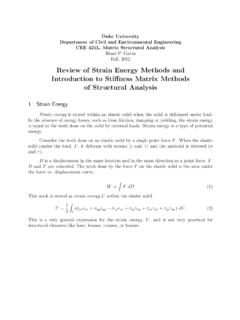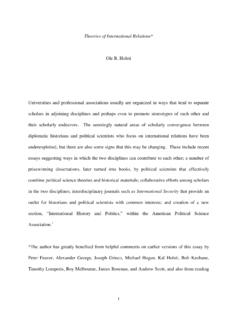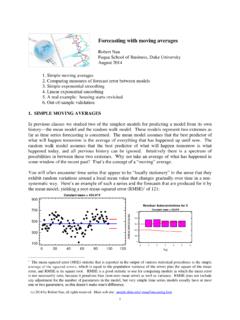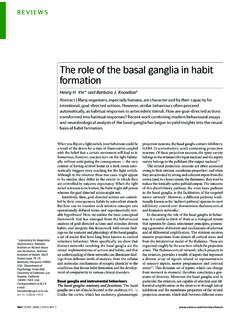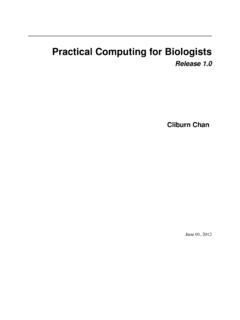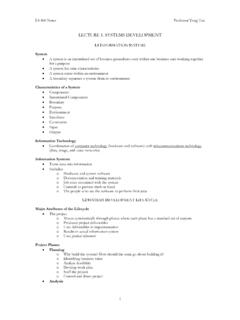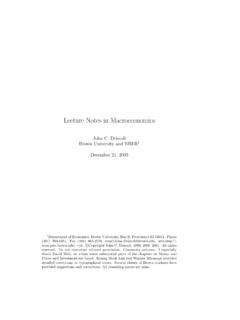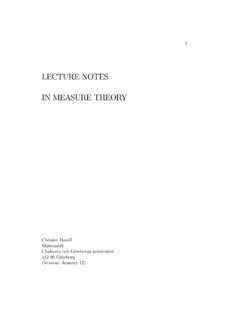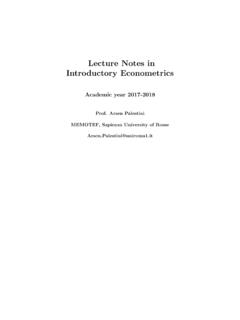Transcription of Notes on linear regression analysis - Duke University
1 Notes on linear regression analysis Robert Nau Fuqua School of Business, Duke University 1. Introduction to linear regression 2. Correlation and regression -to-mediocrity 3. The simple regression model (formulas). 4. Take-aways 1. Introduction 1to linear regression regression analysis is the art and science of fitting straight lines to patterns of data. In a linear regression model, the variable of interest (the so-called dependent variable) is predicted from k other variables (the so-called independent variables) using a linear equation. If Y denotes the dependent variable, and X1, , Xk, are the independent variables, then the assumption is that the value of Y at time t (or row t) in the data sample is determined by the linear equation Yt = 0 + 1 X 1t + 2 X 2t +.
2 + k X kt + t where the betas are constants and the epsilons are independent and identically distributed ( ). normal random variables with mean zero (the noise in the system). 0 is the so-called intercept of the model the expected value of Y when all the X's are zero and i is the coefficient (multiplier) of the variable Xi. The betas together with the mean and standard deviation of the epsilons are the parameters of the model. The corresponding equation for predicting Yt from the corresponding values of the X's is therefore Y t = b 0 + b1X1t + b 2 X 2t + .. + b k X k t where the b's are estimates of the betas obtained by least-squares, , minimizing the squared prediction error within the sample. This is about the simplest possible model for predicting one variable from a group of others, and it rests on the following assumptions.
3 1. The expected value of Y is a linear function of the X variables. This means: a. if Xi changes by an amount Xi, holding other variables fixed, then the expected value of Y changes by a proportional amount i Xi, for some constant i (which in general could be a positive or negative number). b. The value of i is always the same, regardless of values of the other X's. c. The total effect of the X's on the expected value of Y is the sum of their separate effects. (c) 2014 by Robert Nau, all rights reserved. Last updated on 11/26/2014. The material presented in this handout can also be found in html form on the introduction-to- linear - regression page and the mathematics-of-simple- regression page on the main web site: ~ 1. 2. The unexplained variations of Y are independent random variables (in particular, not autocorrelated if the variables are time series).
4 3. They all have the same variance ( homoscedasticity ). 4. They are normally distributed. These are strong assumptions. You can easily imagine situations in which Y might be a nonlinear function of the X's ( , if there are diminishing marginal effects), or in which there might be interactions among the X's in their effects on Y ( , if the sensitivity of Y to one of the X's depends on the values of other X's), or in which the size of the random deviations of Y. from its expected value might depend on the values of the X's ( , if there is greater or lesser uncertainty under some conditions), or in which the random deviations might be correlated in time, or in which the errors are not normally distributed ( , the error distribution might not be bell-shaped and/or might have some really extreme values).
5 A regression model assumes that there are no such nonlinearities or interactions or changing volatility or autocorrelation or non- normality in the random variations. (Further discussion of the assumptions of regression models and how to test them are given on the introduction-to- regression web page and the testing-model- assumptions page on the main web site.). Of course, no model is perfect these assumptions will never be exactly satisfied by real-world messy data but you hope that they are not badly wrong. Just to be clear about all this: A regression model does not assume that Y merely depends in some way on the X's. If you have a variable Y that you wish to predict, and you have some other variables X1, X2, etc., that you believe have some sort of effect on Y or some sort of predictive value with respect to future values of Y, this does NOT suffice to justify using a linear regression model to predict Y from the X's.
6 The regression model makes very strong assumptions about the WAY in which Y depends on the X's, namely that the causal or predictive effects of the X's with respect to Y are linear and additive and non-interactive and that any variations in Y that are not explained by the X's are statistically independent of each other and identically normally distributed under all conditions. The art of regression modeling is to (most importantly!) collect data that is relevant and informative with respect to your decision or inference problem, and then define your variables and construct your model in such a way that the assumptions listed above are plausible, at least as a first-order approximation to what is really happening. There is no magic formula for doing this you need to exercise your own judgment based on your own understanding of the situation and your own understanding of how a regression model works.
7 Choosing a good regression model requires (a) gathering useful data and making sure you know where it came from and how it was measured, (b) performing descriptive analysis on it to understand its general patterns and to spot data-quality problems, (c) applying appropriate data transformations if you see strong evidence of relationships that are nonlinear or noise that is non-normal or time-dependent, (d). fitting and refining and comparing models, (e) checking to see whether a given model's assumptions are reasonably well satisfied or whether an alternative model is suggested, (f). choosing among reasonable models based on the appropriate bottom-line accuracy measure, and (g) deriving some useful insights from the whole process.
8 What story does the model tell about the data, does it make sense to you, is it useful, and can you explain (or sell) it to someone else? 2. In decision-making settings the dependent variable might be some bottom-line measure of revenue or cost or productivity and the independent variables might be things that you control (such as your own prices or the timing of promotions) or that you don't control (such as your competitors' prices or the unemployment rate or the timing of holidays). For example, in an agricultural decision problem, the question of interest might be how crop yields are affected by decisions about chemical treatments and by weather conditions during the growing season. The dependent variable might be the crop yield in bushels per acre and independent variables might be pounds of fertilizers and pesticides applied per acre and amounts of rainfall and average temperatures during the months of the growing season.
9 In a marketing decision problem, the dependent variable might be units of a product sold per week and the independent variables might be numbers of discount coupons distributed, numbers of spot advertisements on TV, and number of in-store displays. In other settings the question of interest may be one of inference or general knowledge, , determining whether one variable has any significant effect on or association with another variable, in order to test a theory or a conjecture or to justify a claim about positive or negative effects of some activity or product or medical treatment. 2. Correlation and regression -to-mediocrity The use of regression models in statistical analysis was pioneered by (Sir) Francis Galton, a 19th Century scientist and explorer who might be considered a model for the Indiana Jones character of the movies.
10 Early in his career, after he inherited a fortune and quit medical school, he went on two expeditions to Africa, the first to the upper Nile Valley and the second through parts of south-west Africa, sandwiched around 5 years of enjoying the sporting life. Based on what he learned from these adventures he wrote two best-selling books The Art of Travel and its sequel, The Art of Rough Travel which offered practical advice to future explorers on topics such as how to treat spear wounds and pull your horse out of quicksand, and he introduced a new item of camping gear to the Western world: the sleeping bag. These authoritative books are still in print and you can order them from Amazon: 3. Galton went on to become a pioneer in the collection & analysis of biometric, anthropometric &.
